The Way It Is/ Return of the turbo
by Gordon Kirby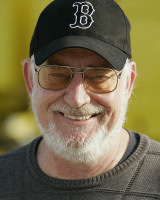 Confirmed last week was the news that a new turbo era will arrive in Indy car racing in 2011 or more likely, 2012. The IRL hopes Audi and one other European manufacturer from Porsche, VW or Fiat will join Honda in committing to a new 2.0 liter single turbo engine formula which will revitalize the flagging sport of Indy car racing. We all know a new IndyCar formula is desperately needed and you have to congratulate the IRL on initiating and conducting its series of 'roundtable' discussions with the manufacturers to try to make a collective decision about what that formula might be.
Confirmed last week was the news that a new turbo era will arrive in Indy car racing in 2011 or more likely, 2012. The IRL hopes Audi and one other European manufacturer from Porsche, VW or Fiat will join Honda in committing to a new 2.0 liter single turbo engine formula which will revitalize the flagging sport of Indy car racing. We all know a new IndyCar formula is desperately needed and you have to congratulate the IRL on initiating and conducting its series of 'roundtable' discussions with the manufacturers to try to make a collective decision about what that formula might be.
"It's really been an open and engaging process," commented IRL commercial president Terry Angstadt. "We could not be more pleased with the reaction we received from beginning the process of soliciting information from the manufacturers prior to going off and setting rules and hoping people participate. I think we flipped it around a little bit and we received a lot of compliments on the process so from that perspective we feel really good about it."
IRL competition president Brian Barnhart echoed Angstadt's remarks and added that one of Audi, Porsche, VW or Fiat will present a formal presentation to its board of directors within the next two months requesting approval for an Indy car engine program for the new formula.
"We've been real pleased with the progress that's been made in the series of roundtable discussions that have taken place," Barnhart said. "We're in a little bit of a waiting game right now. We have engaged multiple manufacturers and we're at a point where at least one of them within the next sixty days should be seeking board approval for participation in the IndyCar series in the future which is exciting times for us."
American Honda's racing boss Erik Berkman said he, too, has been very pleased with the 'roundtable' meetings.
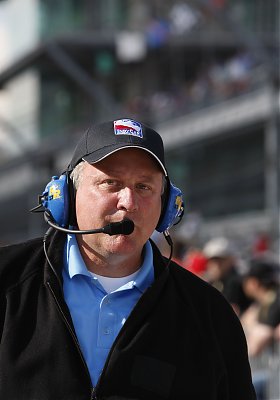
© LAT USA
Angstadt added a cautionary note. "I would encourage everyone to keep in mind that the world has certainly changed since we started this process," Angstadt said. "We really are working through all kinds of economic challenges, not only in our business but our partners and hopefully, our future partners businesses. So we're staying very close to the process and trying to work through those details and issues and hopefully get some increased competition."
Angstadt also addressed the conspicuous absence of any of Detroit's troubled Big Three from the IRL roundtable sessions.
"We would love to see an American manufacturer involved," Angstadt said. "But I think that those companies are more challenged than some of the others and it's pretty well documented as to why. At this stage we really do not have one of the American OEMs engaged and for many pretty good reasons it appears that those companies need to right themselves and get in the right size and produce the right products."
Added Barnhart: "While we may not have them in the short term, if we're successful with the specs that we develop and get competition moving forward perhaps it can create a platform that if and when they right themselves and they're ready to reactively engage the motorsports community, we will already have in play a platform that is relevant technology for the direction they have moved as a company and we would be an attractive option for them at that time."
Barnhart explained the IRL's thinking in returning to a turbo formula. The turbo's whine defined Indy car racing for more than forty years, of course, from the mid-sixties through recent years.
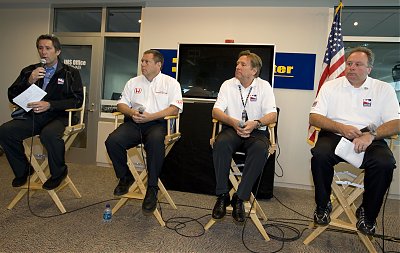
© LAT USA
"With the new package we would like to see similar performance at Indianapolis which is a stand-alone event. We are really proud of the package we have at Indy. We think that in terms of power, downforce and raceability, and the entertainment aspect of it, we feel the last three or four Indianapolis 500s have been among the best with on-track product, reliability, the overtaking, the passing, the lead changes--all those aspects.
"So we want similar performance at Indy and we want some power adjustability at places like Texas and Chicago where we can turn the power down and make it less drag-limited. We think that's an important aspect for the nature of those types of tracks. Then we'd like to improve the performance a little bit on our road course and street circuits.
"It's quite a challenge to create a package that can address all those situations, especially when you make a move to smaller, lighter, reduced-capacity, more efficient engines. That's going to stretch those engines in terms of performance and really create an engineering challenge for the manufacturers."
Barnhart also said because of economic and practical reasons it's likely the new formula will be delayed until 2012.
"As much as we would like 2011," Barnhart remarked. "To be honest, if I had to say, my gut tells me in this economic environment and the reality of the situation we're probably looking more towards 2012. I wouldn't rule-out 2011, but it most certainly and likely could get pushed back to 2012."
Still under debate at the moment is whether the new single turbo 2.0 liter formula will allow V-6s. Honda prefers a V-6 but most other manufacturers would like to see a four-cylinder configuration specified.
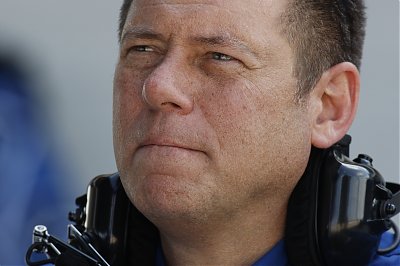
© LAT USA
"For various technical reasons we would prefer a V-6," Berkman continued. "We think that's the right choice. We haven't said it's a deal-breaker yet. I'm not going to use such language and try to run anybody off. We're trying to encourage competition. Some of the other manufacturers are in favor of a four-cylinder and they have their reasons. We all want to have a linkage to our road cars and of course downsizing is coming.
"So we're still debating four versus six and could we entertain both four and six and have an equivalency formula like in some other racing series? We're still talking about fuel, too, and what that should be. But we've narrowed the list of issues down to a pretty short list and we're still talking, so that's the good thing."
There's been some discussion in the roundtable meetings about incorporating KERS or some other green elements. But the manufacturers have strongly suggested delaying such things for a second edition of the formula another three or five years down the road.
"We pride ourselves with the green initiatives that we've had and our positioning with ethanol," Barnhart said. "I think it's important for us to maintain the series position as a leader in innovation and green is vitally important to us. KERS has been talked about since the first roundtable. It's a real challenge with regards to oval track racing and the lack of braking and the lack of the ability to regenerate power. In fact, the manufacturers steered us away from it in the short term or the next generation of specifications we're going to create.
"I think in general as we talked about the relevant technology that an environmentally and socially responsible platform is important and that's the direction we're going to be moving. But most likely without KERS in the next generation because of the oval track challenges."
Berkman expanded on the difficulties in adopting KERS from a manufacturer's perspective.
"We have talked about it a little bit," Berkman said. "I think the consensus of the group was that in trying to deliver on the cost-conscious aspect for the next generation introduction we should keep an open mind and eye toward the evolving technologies related to KERS, or other energy-recovery--thermal or what have you--for possible introduction or application beyond this initial new formula. Think of it as a minor model change we can add at some point. So we wouldn't want to do something that would prevent us from adding a KERS or another kind of energy-recovery or hybrid-type system.
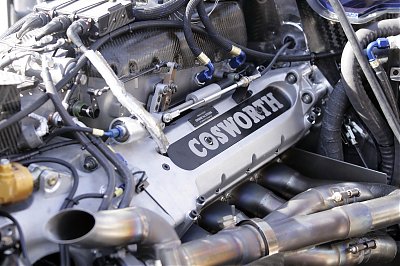
© LAT USA
Berkman added that engineering relevance is a key element for Honda going racing, but he stressed that cost control has become equally important.
"We want to create a socially or environmentally responsible platform," Berkman remarked. "We talk about relevance and the connection for the manufacturers to the products we sell. We need to have a production-technology linkage for racing so that we can have a marketing message and communication.
"And then there's cost consciousness. There's no reason why racing has to be so expensive all the time. We want to make it stable for everyone. We want to have competition but there has to be some controls put in place and we gained consensus from all the manufacturers on these major points.
"We need to create a clean sheet of paper approach," Berkman continued. "But we have to put some controls in place so that the competitors aren't allowed to create a cost escalation that benefits no one. The manufacturers need a technical challenge. My colleagues in the other car makers are talking the same that we can't allow the technical pursuit to die out. We need the challenge and we need a clean sheet so that nobody has the advantage from the beginning and we need to establish the rules with the League so that we don't allow the costs to get out of control."
To this end the IRL plans to enforce a five-year, sealed engine homologation program with its new formula. There will also be a ceiling on engine lease fees and each engine will be required to run 3,750 miles between rebuilds.
"All three are obviously for cost-containment and reduction of the levels of the cost of participation," Barnhart commented. "The five-year homologation period is to protect the manufacturers from continual R&D budgets that skyrocket out and it certainly helps the League from the standpoint of keeping the playing field as level of possible. They're all very much works in progress but I think the most important aspect among all is that extended engine life is less rebuilds and that costs less money.
"We want to create a successful business model for the manufacturer to get involved with the series. You don't want the manufacturer to be outspending what the value of the series is because they won't stay in very long regardless of competition or not. You've really got to have a successful and sound business model put in place for the manufacturers when they make the commitment to come and join. We've got to create a sound business model in a competitive environment or we won't be in a competitive environment very long."
Barnhart and Angstadt hope to convince Honda and two other manufacturers to commit to the IRL's 2011/'12 formula.
"We really don't know where we're going to end up with this process," Barnhart observed. "It's a different world since our first roundtable meeting and while we're hopeful, we may not get any of them. The fact that we've got five of them involved in this global economy I think speaks volumes. The fact that we've got five of them this engaged this far down the path is a really good indicator about the interest in the future of the IndyCar series. If we could get two of them to join Honda and we came out of this with three manufacturers it would be absolute, pure happiness on our side."
Added Angstadt: "We would love to see three manufacturers but we'll see where it leads us. There are certainly a couple very engaged right now on top of our partners from Honda, so we're encouraged."
Barnhart said the IRL has made a point in including independent race engine builders in its meetings with the manufacturers to be sure to cover all its bases and be prepared for any and all situations with or without manufacturer support.
"We've always included from the first roundtable with the manufacturers the Cosworths, the Ilmors and the AERs," Barnhardt remarked. "The specialized race engine builders are important to us. Even with manufacturer involvement we've thrown it on the table from day one and they've all appreciated and understood and been open to competing against the Cosworths and Ilmors as well. So they're very much still in play. They're an important aspect in what's happened historically around racing and I think they provide additional opportunities for competition in the future.
"Again, it's a vastly different world in the last three months alone, so while this is still the direction we're hoping and planning for, we by no means have any guarantees. We're trying to cover all our bases--best case scenarios and fall-back insurance plans. We're having conversations and talking with everybody at any given time about all kinds of options."
Barnhart also said he believes the IRL will draw a stronger field than many people expect this year.
"I think we're going to be surprised," Barnhardt observed. "In this economic environment we've kind of been anticipating perhaps a significant downturn but I've come to the conclusion that we might be better-positioned from the League's standpoint to be less-affected by the economic climate than perhaps other racing series. While we may not match the full numbers of what we had with the first year of unification last year, the indications are that we might not be down too much. We've got a couple of [teams] that look like being down and we've got a couple of them that look like they're coming onboard. I think anywhere from 22 to 24 could show up on the grid at St. Pete for our season-opener and I think that would be a pretty strong statement."
Trouble is, with so little commercial power and media coverage Indy car racing has become essentially a rentadriver category filled with far too many Milka Dunos and Mario Moraes and not enough Paul Tracys, Ryan Hunter-Reays and Justin Wilsons.
The IRL should praise the heavens for Dario Franchitti's return because he's the series only real star. Teammate and defending champion Scott Dixon is an excellent driver and fine fellow, but not a star type. Penske's pair of Australian drivers may be very good shoes, but both are largely unknown across America. Tony Kanaan has some star power but teammates Marco Andretti and Danica Patrick need to grow up and start focusing on their jobs and acting like professionals if they're going to be taken seriously. Graham Rahal is a natural waiting to prove himself and new teammate Robert Doornbos will be strong in many races.
But in terms of major stars and public appeal Indy car racing has worn itself very thin. Two or three long and difficult years lay ahead before the arrival of Indy car racing's desperately needed new turbo age.
Auto Racing ~ Gordon Kirby
Copyright 2009 ~ All Rights Reserved
Copyright 2009 ~ All Rights Reserved
Top of Page